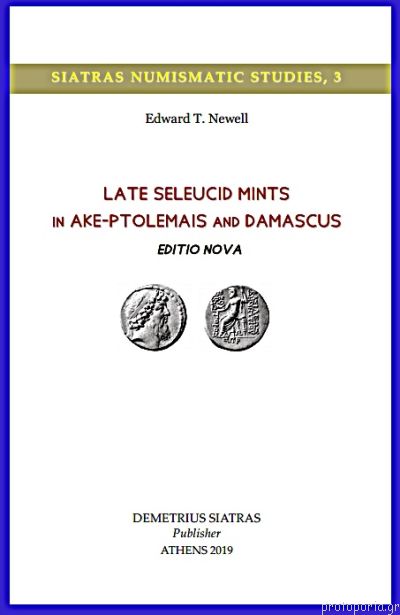0
Your Καλαθι
Late Seleucid Mints in Ake-Ptolemais and Damascus
Editio nova
Έκπτωση
10%

10%

Περιγραφή
Re-edition of a classical work with new typesetting. Edited and published by Demetrius Siatras.
As province after province fell, or was forcibly taken away from the declining Seleucid empire, certain minor mints grew in importance as useful subsidiaries of the great central establishment at Antioch. Their activity even increased when the shrunken core of the once mighty empire commenced to break into parts during the fratricidal wars between the last of the Seleucid scions.This book presents and discusses the issues of two of these mints particularly active during the last half-century of Seleucid domination.
Ake-Ptolemais is first known as a Seleucid mint by the issue of local bronze coins bearing the portrait of Antiochus V, but it mostly known for the series of “Ptolemaic” tetradrachms with the eagle on the reverse struck under the influence exercised over Palestine and Phoenicia by the Ptolemies.
Damascus first comes into numismatic prominence with the capture of the city by Parmenion and the establishment there of a very active mint. This activity continued under Alexander’s immediate successors. Thereafter the mint went into a temporary decline. Later, the city gradually revived to become once more the most important inland centre of all the Syrian hinterland. It is not, however, until the reign of Antiochus VII that its coin issues become sufficiently obvious for us to recognize them with certainty. But from that time forward they continue, almost without interruption, until the very end of the Seleucid rule and the acquisition of Damascus by the Nabataeans.
As province after province fell, or was forcibly taken away from the declining Seleucid empire, certain minor mints grew in importance as useful subsidiaries of the great central establishment at Antioch. Their activity even increased when the shrunken core of the once mighty empire commenced to break into parts during the fratricidal wars between the last of the Seleucid scions.This book presents and discusses the issues of two of these mints particularly active during the last half-century of Seleucid domination.
Ake-Ptolemais is first known as a Seleucid mint by the issue of local bronze coins bearing the portrait of Antiochus V, but it mostly known for the series of “Ptolemaic” tetradrachms with the eagle on the reverse struck under the influence exercised over Palestine and Phoenicia by the Ptolemies.
Damascus first comes into numismatic prominence with the capture of the city by Parmenion and the establishment there of a very active mint. This activity continued under Alexander’s immediate successors. Thereafter the mint went into a temporary decline. Later, the city gradually revived to become once more the most important inland centre of all the Syrian hinterland. It is not, however, until the reign of Antiochus VII that its coin issues become sufficiently obvious for us to recognize them with certainty. But from that time forward they continue, almost without interruption, until the very end of the Seleucid rule and the acquisition of Damascus by the Nabataeans.
Κριτικές
Δεν βρέθηκαν δημοσιεύσεις




